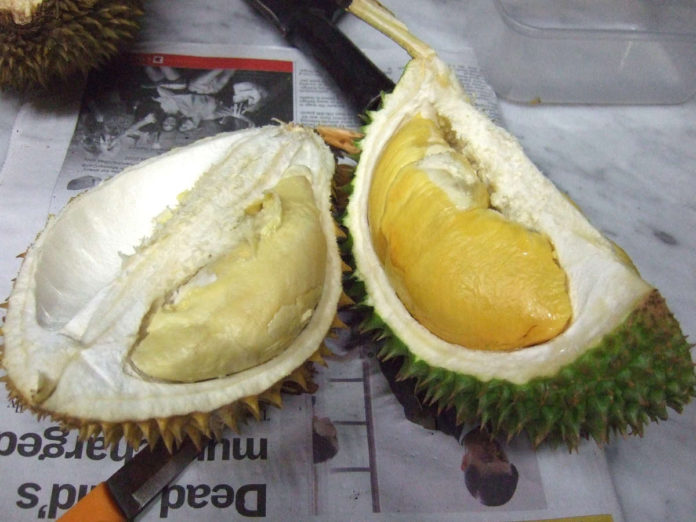This year, the harvest festival known as the Mooncake Festival was celebrated by Chinese and other Eastern and Southeastern Asian cultures on September 17, the night when the harvest moon was thought to be the fullest and brightest. The festival dates back thousands of years and is celebrated with dancing, lantern displays and by eating mooncakes. There are many different kinds of mooncakes filled with ingredients such as sweet beans, lotus-seed paste and spiced meats. Another popular mooncake filling is made with the deliciously sweet durian fruit. However, just because this year’s Mooncake Festival is over does not mean you will have to wait another year to sample durian. There are plenty of other delicious foods that use it as an ingredient.
There are about 30 species of tropical trees belonging to the genus Duri, of which nine produce edible fruits called durians. A typical durian tree can produce fruits from flowers usually pollinated by bats during its biannual fruiting cycles. A mature durian tree can have a life span of 150 years, can grow up to 165 feet tall, and produce well over 300 fruits annually. Unfortunately, durian trees only grow in tropical climates with their ideal temperature range of 75 to 86 Fahrenheit. Although they can tolerate higher temperatures, they will die at prolonged temperatures below 75F. This, and the relatively low humidity of Bay Area gardens mean that durian trees cannot be grown locally.
Durian, also referred to as the “King of Fruits” in some Asian countries, is a large fruit, sometimes up to 18 pounds, that has a thick tough spiny outer rind and contains a custard-like pale yellow flesh and large seeds. The flavor of the creamy pulp when the fruit is ripe is often compared to the taste of caramelized banana, vanilla, egg custard, almonds and cheesecake with occasional hints of garlic, sherry, cheese and onion sauce. Durian seeds are edible but are toxic if eaten raw. Cooked seeds have a nutty flavor and the texture of a baked potato. Young durian leaves can be cooked and eaten as greens.
Durians are not without controversy. They have been banned from being eaten in some Southeast Asian hotels, airports and public places, as well as on subways and trains. This is because durians have a pungent smell that some people like and some loathe. Sewer gas, rotten eggs, stale vomit and dead animals are a few of the descriptions people give the ripening fruit. Honey, fresh fruit and caramel are the scents associated with people who find the aroma pleasant. Some people cannot smell the ripening fruit at all. Familiarity can also influence whether or not a durian smells good or bad. People who grew up enjoying the fruit do not tend to think it smells bad.
The good news is that the strong aroma does not impact the delicious flavor of the pulp inside. Durian is eaten by itself or used as an ingredient in many types of cuisine throughout China and Southeast Asia. It is used as a base for curries, sauces, fillings for doughnuts, in cheesecakes, fritters, breads, ice cream and as durian chips to name just a few. There is no limit to the number of sweet or savory dishes that durians can enhance. Tempoyak is a fermented durian condiment commonly eaten with rice or used in curries. It was developed as a way to preserve over-ripe or poor-quality durians.
Durian is one of the more expensive fruits to purchase. It requires a lot of time until the fruit is ready to harvest. Depending on the variety, that could be anytime from 90 to 150 days. There is a lot of labor involved. Each durian is harvested individually by workers climbing amongst the thorny branches. They cut the fruit free with a knife and then lower the fruit with a thin rope to someone on the ground. The fruit is then transported to processing centers that meticulously sort them on quality, grade and expected preparation processes. They are then thoroughly cleaned. Durians that are not distributed to markets as whole fruits get processed and packaged by human workers, not machines.
Fresh durians are not imported to the U.S. However, frozen or freeze-dried durian can be purchased at many Bay Area Asian markets. Many of these markets also offer imported durian flavored foods, sauces and desserts. Some local Asian bakeries make freshly baked durian flavored pastries and breads. Pineapple King Bakery in Warm Springs, Fremont (pineapplekingbakery.com) sells durian mooncakes, their most popular flavor, every year from mid-September to early October.
Durian demand is going up worldwide particularly in the US, England and Germany in part due to cross cultural food trends and food blogging. This means you do not have to wait until the next year’s Mooncake festival to sample durian, but if you do, maybe the durian mooncake will shine brighter for you than the full moon.
Daniel O’Donnell is the co-owner and operator of an organic landscape design/build company in Fremont. www.Chrysalis-Gardens.com.




